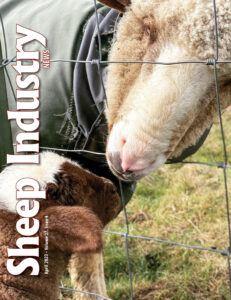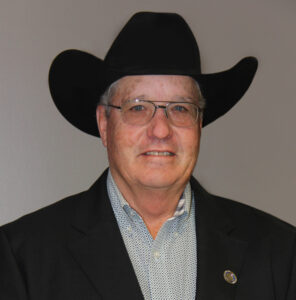With the lamb market crashing in the summer of 2022, Whit Stewart and his colleagues at the University of Wyoming headed to the Wyoming Wool Growers Association meeting to announce the newly established Wyoming Wool Initiative.
Based on previous success with a blanket program that had been overwhelmingly supported by the state’s sheep producers, organizers put together a new idea to develop a Lamb-a-Year program and were looking for support once again from those same producers.
“We were really hesitant to roll it out last summer,” said Stewart. “We talked about waiting a year, but what’s so remarkable about the producers we work with is that they were still willing to donate those lambs. We let the producers know that there was no obligation, but it still came together. The hardest part wasn’t getting people to sign up and donate lambs, it was just coordinating the logistics. I spent a couple of Saturdays driving around in a truck and trailer picking up lambs.”
The key to the initiative’s early success is simple. Educators, students, producers and the industry have all been willing to collaborate on the project with the hope of generating a beneficial path for all involved. Educators gain new resources to teach their students, who in turn generate research and data to assist producers. Those same students will then be better prepared to take roles in the industry – whether it’s as producers, in lamb processing, wool manufacturing or continued research. Support from the university – specifically College of Agriculture, Life Sciences and Natural Resources Dean Barbara Rasco and Associate Dean Eric Webster – also played a crucial role in the program’s early success.
As an associate professor and sheep extension specialist, it’s no accident that Stewart helped develop such a program. His role at the university is split evenly between teaching, research, and extension duties.
“So, we try to integrate all aspects of our program so that they’re synergistic and work together, because there’s just not enough time and resources otherwise,” Stewart said.
“It’s the students who really drive these programs on campus and make the research work, and that prepares them to go out into the industry and get involved on a professional level.”
The word “collaboration” comes up time and again in conversations about the program, which has collaborated with ASI, the Wyoming Wool Growers Association, Superior Farms, Mountain Meadow Wool and the U.S. Department of Agriculture’s Agricultural Research Service in addition to countless producers throughout the state.
Blanket Beginnings
“About two years ago, Whit had the idea to shear the university’s sheep, make some wool blankets with it and hope we earned enough for some kind of programming,” said his wife, Lindsay Conley-Stewart, who has a fine arts degree from Wyoming and has designed each of the blankets sold through the program. “We made 300 blankets, so I came on in support to facilitate all of the logistics and marketing efforts. It ended up being wildly successful and that opened our eyes that we had this way to garner resources for various needs that weren’t being met in the sheep program. And that’s what became the Wyoming Wool Initiative. The blanket project is still a part of it, but it’s just a small piece of a much bigger program.”
Naturally attached to the blankets she designed and somewhat fond of the man behind the project, Conley-Stewart soon signed on for role of project coordinator. In addition to her position with the initiative, she coordinates social media and marketing efforts for the College of Agriculture.
“It’s kind of nice that all the nights I spent away from home in our 15 years of marriage, now she sees our industry and gets to be a part of it,” Stewart said. “I guess I could be accused of being the idea guy, but she’s the closer. If it wasn’t for her, we probably would have designed an ugly blanket, sold just a few and quit after the first year. She’ll mockup four or five different designs and people around the university will vote on them. That visual and storytelling element that she brings is why the blankets have looked as good as they have.”
Success with the blankets paved the way for other ideas to take root.
Lamb-A-YEar
Based on popular steer-a-year programs, the Lamb-A-Year concept asked sheep producers to donate lambs to the university. Students then fed and worked the lambs as part of a newly created class, earning school credit while getting hands-on experience in rearing a flock.
The first group of the approximately 155 donated lambs went to Superior Farms’ plant in Denver earlier this year. But they didn’t go alone. A team of graduate students led by Dr. Cody Gifford – an assistant professor in meat science – was there to collect carcass data on each individual lamb.
“This program demonstrates the importance of collecting phenotypic data to the contributing producers and students alike,” said Superior Farms Director of Producer Resources Karissa Isaacs. “Collecting production data is just as important as the lamb performance or carcass data being collected to help with on-farm management and breeding decisions for future success of a sheep operation. Superior Farms looks forward to seeing results from the University of Wyoming for year one and to continued collaboration for the benefit of the lamb industry.”
Producers benefit from receiving a package of information on each lamb, including growth performance data, loin eye photos and final carcass data.
“We worked hard to implement some alternative management with these lambs,” Stewart said. “We backgrounded the lambs and tried to grow them really cost effectively at a slow rate of gain to get closer to the Easter market. We’ll have two groups that were harvested about a month and a half apart. I hope the producers are happy with the information they get back. In Wyoming, lambs get sold and the producers don’t always know how well they do in the feeding phase or when they reach the harvest phase. We feel like we were able to give them a lot of information to make some more well-informed decisions down the road.”
All totaled, 26 producers donated lambs and three gave cash donations to support the program. NexGen Feed Solutions also donated in the form of 10,000 lbs. worth of feed to support the program.
“I had one producer call me and say, ‘Lindsay, the Wyoming Wool Initiative needs to be a generational program. It can’t be something that is a flash in the pan. Programs like this will help the industry thrive instead of just survive,’” Conley-Stewart said. “And that was really touching to me about the work we’re doing and the importance of it.”
While 2022 was a difficult year for the lamb market, sometimes that’s the perfect time to get producers to try something different. When prices are high, there’s little incentive to take a step in a different direction.
“We’re a bit heavy on Merino now, so I wanted to see how they stacked up as a baseline to what we’ve done in the past,” said Ivan Laird, who raises a small flock of Merino-Rambouillet crosses in Lander, Wyo. “I wanted to build up the wool, but not hurt the carcass cutout. But I also think its important to give back to these students, and that’s why I did it. It’s a great opportunity to put some animals out there for the students to work with. We lost so much when we didn’t have a sheep extension specialist for several years, so it’s nice to have someone bringing some enthusiasm to that role.”
American Wool Assurance
Through the work of the Wyoming Wool Initiative, the university’s flock became the first in the United States to reach Level III (Certified) status in ASI’s American Wool Assurance Program in February 2022.
“ASI would like to congratulate the University of Wyoming for reaching Level III certification,” said ASI Deputy Director Rita Samuelson at the time. “The association also owes the university a debt of gratitude for its assistance in finalizing the audit process that will lead to producers throughout the United States having the opportunity to reach Level II (Process Verified) and Level III (Certified).”
Graduate student Courtney Newman and Laramie Research and Extension Center Assistant Manager and Sheep Unit Manager Kalli Koepke deserve most of the credit for this accomplishment, according to the Stewarts.
“Courtney took those blankets and used them as a case study for traceability with Mountain Meadow Wool, so that we can really prove where certain products are made and where they come from,” Stewart said. “With traceability, we feel like we can help producers get more for their wool. So, that’s a grass roots example of the university and industry coming together that might generate more income for the producer. I’d love to ride off into the sunset one day knowing that producers are making more money because of the stuff we researched and implemented.
“We’re in the second year of Courtney’s project and now looking at when the product is changing hands several times in the manufacturing process, so that’s a big push for us this year to get that accomplished.”
Newman earned ASI’s Sheep Heritage Foundation Scholarship in 2022 in part because of her work on traceability. She’s looking to incorporate blockchain technology into wool processing as part of her studies and became just the latest of several students who have studied under Stewart to win the scholarship. Stewart was a recipient of the scholarship himself back in 2014.
Lasting Legacy
While producers might benefit financially from these programs, the long-term value is in the young professionals the university is sending out into all facets of the American sheep industry. The Wyoming Wool Initiative is nearing its first birthday, but the university has been turning out future leaders for far longer.
“We all have a shelf life on our careers,” said Stewart, who’s been at the University of Wyoming for approximately six years since leaving Montana State University. “The students are a legacy that lives on. I feel like that’s something the industry has lacked at times was the ability to kick out new leaders, but we’re really investing in that at the University of Wyoming. And through the Wyoming Wool Initiative, the producers and the industry are investing in them, as well.”
While it would be impossible to highlight them all, Stewart points to Dallin Brady at Center of the Nation Wool, Alexis Brady at Julian Land and Livestock, Nicole McKibbon at Superior Farms, Jaelyn Whaley with South Dakota State University Extension and Dr. Chad Page at Utah State University as a few examples of the university’s success in sending students into the industry.
“And we’ve got some really great students that are still here in the program,” he added. “Our job isn’t done until they are placed and working in the industry. We want to do what we can to help them finish their studies and their research and then kick them out into sheep industry careers.”



